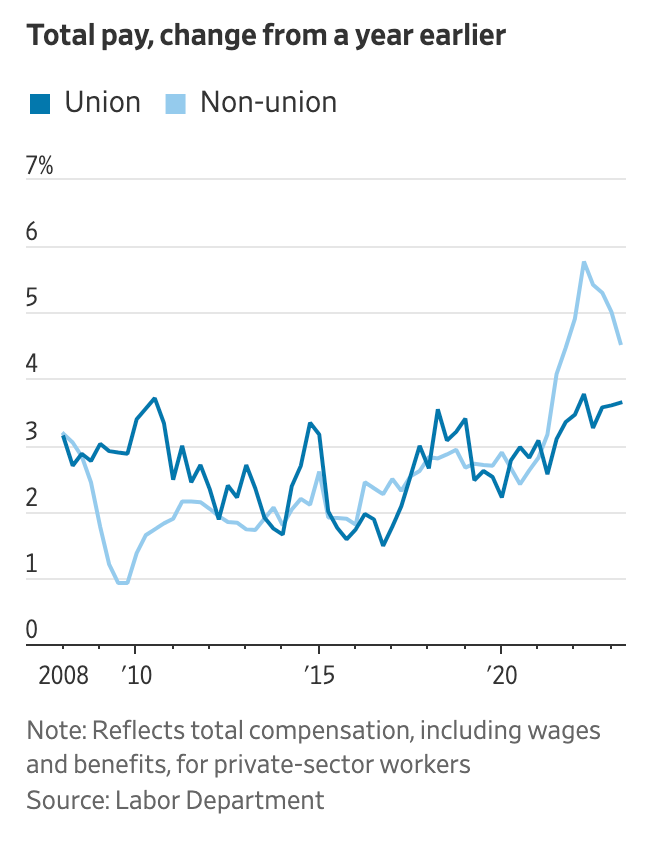Union workers' increases fell behind non-union workers during the pandemic
A tight labor market pushed non-union employers to push raises in total compensation higher than unionized employers.
Total compensation for non-union workers increased more than union workers during the pandemic.
Some interesting data in a Wall Street Journal article this morning about unions flexing their muscles during a tight labor market reveals that increases in total compensation for union workers lagged behind total compensation increases for non-union workers during the pandemic.
“In some cases,” the WSJ notes, “the unions’ latest gains just catch up to pay increases that nonunion Americans landed since the pandemic hit the U.S. economy in 2020.”
Wages and benefits for nonunion workers were up 15.8% from the end of 2019 through June, compared with a 12.2% gain for unionized workers, according to the Labor Department. Union workers earn more on average but accounted for just about 10% of the workforce in 2022, a record-low share.
It makes sense. Although the tight labor market obviously helped push non-union total compensation higher than union total compensation, there may be other reasons behind it.
During the pandemic, as non-union employers were able to push their compensation higher as needed, many unions were likely mid-term in their contracts and, as a result, had to wait for their contracts to expire in order to negotiate higher increases.
Additionally, due to the fact that union contracts are most commonly multi-year contracts, many unionized employers negotiate their union contracts with economic forecasts in mind.
If it is expected, for example, that the economy will be entering a recession, employers negotiating union contracts may have a tendency to be more frugal with their negotiated increases over time. This often results in ‘front-loaded contracts.’
Non-union employers trimming increases? Now that the pandemic-related labor shortage is easing and the competition for new employees is less fierce, some non-union employers are cutting back on their budgeted increases for 2024.
“Overall, employers are planning on salary budget increases of 3.8% on average in 2024,” Payscale.com stated in a July release.
Some employers are trimming in other ways.
Walmart, for example, announced last week that its new wage restructuring reduces the starting pay rate for some new hires.
“The new wage structure also led to a pay raise for about 50,000 existing employees who were making less than new minimums the company adopted in certain job categories,” Bloomberg reported.
Although union members had median usual weekly earnings of $1,216 in 2022, while nonunion workers had median weekly earnings of $1,029, according to the Bureau of Labor Statistics (BLS), the BLS adds that “these earnings differences reflect a variety of influences, including variations in the distributions of union members and nonunion employees by occupation, industry, age, firm size, or geographic region.”
Read the whole Wall Street Journal article here.
Read also: Union Incomes May Seem Better Than Non-Union, But Are They Really?





